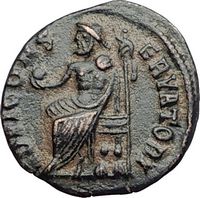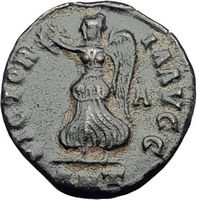Anonymous "Great Persecution of Christians Issue"
struck under: Maximinus II, Daia - Roman Emperor: 308-313 A.D. -
Bronze Quarter-Nummus 15mm (1.62 grams) Antioch mint, struck circa 310-313 AD.
Reference: Vagi 2955 var.; Van Heesch, Last 2; McAlee 171
IOVI CONSERVATORI, Jupiter as "Zeus Nikephoros" seated left, holding globe and scepter.
VICTORIA AVG G Exe: A/ANT, Victory advancing left, holding wreath and palm branch. PAGAN COINAGE OF THE GREAT PERSECUTION
Though formerly attributed to the period of Julian II, these pieces were struck c. 305-313 as part of The Great Persecution of Christians in the east by Diocletian, Galerius and Maximinus II Daia. Though the persecution of Christians had occurred under many previous regimes since the 1st Century, it was pursued assiduously by the Tetrarchs. Indeed, it was only halted (it would seem) when they determined that it was working to the advantage of Constantine the Great, who embraced the religion as a result. Associated with the persecution is a series of 'autonomous' coins struck at the cities of Antioch, Nicomedia and Alexandria. The bulk of these coins were probably struck c. 310-312 under Galerius or Maximinus Daia (though the issues of Nicomedia can perhaps be attributed to Galeria Valeria, the second wife of Galerius). The issues of Alexandria occur in two denominations and celebrate Serapis and Nilus. With the voluminous issues of Antioch we find a variety of mint marks, officinae and control marks, which suggest the output was large and complex. Depicted on the issues of Antioch are some of the city's most famous statues: the Tyche erected by Eutychides (a pupil of Lysippus), the Apollo by Bryaxis of Athens, and possibly the Zeus Nikephoros of the Temple of Apollo at Daphne which Antiochus IV commissioned for his great festival of 167 B.C. You are bidding on the exact item pictured, provided with a Certificate of Authenticity and Lifetime Guarantee of Authenticity.
The Diocletianic or Great Persecution was the last and most severe Persecution of Christians in the Roman Empire. In 303, the Emperors Diocletian, Maximian, Galerius, and Constantius issued a series of edicts rescinding the legal rights of Christians and demanding that they comply with traditional Roman religious practices. Later edicts targeted the clergy and ordered all inhabitants to sacrifice to the Roman gods (a policy known as universal sacrifice). The persecution varied in intensity across the empire-weakest in Gaul and Britain, where only the first edict was applied, and strongest in the Eastern provinces. Persecutory laws were nullified by different emperors at different times, but Constantine and Licinius's Edict of Milan (313) has traditionally marked the end of the persecution. 
The Christian Martyrs' Last Prayer, by Jean-Léon Gérôme (1883)
Christians had always been subject to local discrimination in the empire, but early emperors were either too reluctant to issue general laws against them or, at least in the 3rd century (see Crisis of the Third Centuryy), too caught up with more immediate issues to do so. It was not until the 250s, under the reigns of Decius and Valerian, that such laws were passed. Under this legislation, Christians were compelled to sacrifice to Roman gods or face imprisonment and execution. When Gallienus acceded in 260, he issued the first imperial edict regarding tolerance toward Christians, leading to nearly 40 years of peaceful coexistence. Diocletian's accession in 284 did not mark an immediate reversal of disregard to Christianity, but it did herald a gradual shift in official attitudes toward religious minorities. In the first fifteen years of his rule, Diocletian purged the army of Christians, condemned Manicheans to death, and surrounded himself with public opponents of Christianity. Diocletian's preference for autocratic government, combined with his self-image as a restorer of past Roman glory, presaged the most pervasive persecution in Roman history. In the winter of 302, Galerius urged Diocletian to begin a general persecution of the Christians. Diocletian was wary, and asked the oracle of Apollo for guidance. The oracle's reply was read as an endorsement of Galerius's position, and a general persecution was called on February 24, 303. Persecutory policies varied in intensity across the empire. Where Galerius and Diocletian were avid persecutors, Constantius was unenthusiastic. Later persecutory edicts, including the calls for universal sacrifice, were not applied in his domain. His son, Constantine, on taking the imperial office in 306, restored Christians to full legal equality and returned property that had been confiscated during the persecution. In Italy in 306, the usurper Maxentius ousted Maximian's successor Severus, promising full religious toleration. Galerius ended the persecution in the East in 311, but it was resumed in Egypt, Palestine, and Asia Minor by his successor, Maximinus. Constantine and Licinius, Severus's successor, signed the Edict of Milan in 313, which offered a more comprehensive acceptance of Christianity than Galerius's edict had provided. Licinius ousted Maximinus in 313, bringing an end to persecution in the East. The persecution failed to check the rise of the church. By 324, Constantine was sole ruler of the empire, and Christianity had become his favored religion. Although the persecution resulted in death, torture, imprisonment, or dislocation for many Christians, the majority of the empire's Christians avoided punishment. The persecution did, however, cause many churches to split between those who had complied with imperial authority (the traditores), and those who had remained "pure". Certain schisms, like those of the Donatists in North Africa and the Meletians in Egypt, persisted long after the persecutions. The Donatists would not be reconciled to the Church until after 411. In the centuries that followed, some historians claim that Christians created a "cult of the martyrs", and exaggerated the barbarity of the persecutory era. These accounts were criticized during the Enlightenment and afterwards, most notably by Edward Gibbon. Modern historians, such as G. E. M. de Ste. Croix, have attempted to determine whether Christian sources exaggerated the scope of the Diocletianic persecution.
Gaius Valerius Galerius Maximinus (20 November, c. 270 - July/August, 313) Roman emperor from 308 to  313, was originally named Daia. He was born of peasant stock to the half sister of the Roman emperor Galerius near their family lands around Felix Romuliana; a rural area now in the Danubian region of Serbia, then the newly reorganised Roman province of Dacia Aureliana subordinated to the later Prefecture of Illyricum). 313, was originally named Daia. He was born of peasant stock to the half sister of the Roman emperor Galerius near their family lands around Felix Romuliana; a rural area now in the Danubian region of Serbia, then the newly reorganised Roman province of Dacia Aureliana subordinated to the later Prefecture of Illyricum). He rose to high distinction after he had joined the army, and in 305 he was adopted by his maternal uncle, Galerius, and raised to the rank of caesar, with the government of Syria and Aegyptus. In 308, after the elevation of Licinius to Augustus, Maximinus and Constantine were declared filii Augustorum ("sons of the Augusti"), but Maximinus probably started styling himself after Augustus during a campaign against the Sassanids in 310. On the death of Galerius, in 311, Maximinus divided the Eastern Empire between Licinius and himself. When Licinius and Constantine began to make common cause with one another, Maximinus entered into a secret alliance with the usurper Caesar Maxentius, who controlled Italy. He came to an open rupture with Licinius in 313, he summoned an army of 70,000 men, but still sustained a crushing defeat at the Battle of Tzirallum, in the neighbourhood of Heraclea Pontica, on the April 30, and fled, first to Nicomedia and afterwards to Tarsus, where he died the following August. His death was variously ascribed "to despair, to poison, and to the divine justice".[citations needed] Maximinus has a bad name in Christian annals, as having renewed persecution after the publication of the toleration edict of Galerius (see Edict of Toleration by Galerius). Eusebius of Caesarea[1], for example, writes that Maximinus conceived an "insane passion" for a Christian girl of Alexandria, who was of noble birth noted for her wealth, education, and virginity. When the girl refused his advances, he exiled her and seized all of her wealth and assets.
|



 313, was originally named Daia. He was born of peasant stock to the half sister of the Roman emperor Galerius near their family lands around Felix Romuliana; a rural area now in the Danubian region of Serbia, then the newly reorganised Roman province of Dacia Aureliana subordinated to the later Prefecture of Illyricum).
313, was originally named Daia. He was born of peasant stock to the half sister of the Roman emperor Galerius near their family lands around Felix Romuliana; a rural area now in the Danubian region of Serbia, then the newly reorganised Roman province of Dacia Aureliana subordinated to the later Prefecture of Illyricum).
